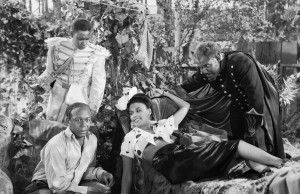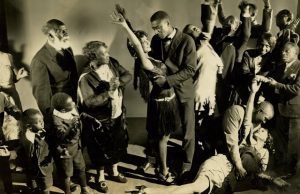An American Romance (1944)

Toronto Film Society presented An American Romance on Sunday, August 4, 2013 as part of Season 66 Raiding the Vaults at the George Eastman House Weekend.
Despite the fact that there is little marquee strength in the person of several proven name stars in this picture, “An American Romance” is bound to create a storm of controversy, based upon its plot and general treatment of labor vs. capital. So much so that this romantic drama, on the basis of that impetus, should garner topflight grosses wherever exhibited.
One of Metro’s greatest efforts (execs state that the picture was two years in the making and cost over $3,000,000), this film will zoom Brian Donlevy into the constellations as one of Hollywood’s most important actors. It’s his baby from opening to closing, and his performance as the Czech immigrant who runs the gamut from poverty to become a wealthy industrialist, is one of the most understandable, warm and neatly woven portrayals to hit the screen in many a moon.
King Vidor’s story, coupled with his forthright direction and the excellent acting, are assets that add up to a winning total. The one fault with “Romance” is that it is much too long in the telling. A tightening-up process, in which at least 40 minutes of the 151-minute runoff is eliminated, would aid this romantic narrative immeasurably.
Yarn takes more than an hour to get down to business. During that hour, true, Vidor lays the setting for the rest of the film, showing how Donlevy, who is held up at Ellis Island on landing in America because he did not own the equivalent of $25 in U.S. money, overcomes his poverty by hard work in the Mesabi iron ore pits of Minnesota, and meets the girl whom he is to marry (Ann Richards). Donlevy, eager to learn the modes and history of America, also takes advantage of the fact that she is a schoolteacher, delving into the chemistry of steel-making and the functions of industry.
With this background, Donlevy makes his way to a large city in the industrial Midwest, and works his way up to foreman of a section of a steel mill. He sends for his fiancée in Mennesota, they wed, and have five children. Meanwhile, he begins the manufacture of autos. Through the aid of funds of his cousin Anton (John Qualen) and the business acumen of his partner (Walter Abel), all this soon results in the success of the business.
However, the men working in the auto plant wish to organize a union, and Donlevy’s son joins with them in their demands. A confirmed individualist, Donlevy refuses to give in to their demands, and so, when his board of directors votes to settle a three-month strike by acceding, he retires from the firm. In the end, though, Donlevy comes out of retirement ot take over the outfit’s new airplane building plant in California.
Photographed in beautiful Technicolor, this romantic drama is notable for the documented montage shots of the intricate mining and shipping of iron ore: the making of steel in the huge mills of the Midwest; films showing the way autos are made and the excellent details of airplane-making.
Once “Romance” starts moving, it proves to be a mighty appealing picture. The support given Donlevy by Miss Richards, Walter Abel and John Qualen adds much to the enjoyment of the film, especially the job done by Abel.
Vidor hasn’t had a tremendous winner in a long time. This vehicle may well be the one to again establish him at the pinnacle of the producer-director ladder. With the apparently unlimited budget allowed him by Metro, and the fine camera work of Harold Rosson, Vidor has turned out a likable film that is going to create much discussion, all to its advantage at the b.o.
VARIETY, Sten., June 28, 1944
AN AMERICAN ROMANCE, screen play by Herbert Dalmas and William Ludwig; baed on a story by King Vidor; produced and directed by King Vidor for Metro-Golwyn-Mayer.
A wonderful opportunity, plus considerable money and time, were spent by King Vidor and Metro in attempting to vision on the screen the vast vitality of American industry in Mr. Vidor’s “An American Romance.” But certainly the opportunity was squandered in a most distressing way, as evidenced by the finished product which opened at Loew’s State yesterday. For Mr. Vidor made a great big color picture with an abundance of vivid American scenes but with a story so banal and tedious that the whole film seems one massive platitude.
Surely there is solid bone and sinew in our huge industrial network. Certainly there is thrilling inspiration in the cosmic drive of men and machines. The range of human passions and much of the drama in modern life are embraced by the titanic grapple of American industry. Such a truly tremendous picture could be made upon this theme—and only a picture could grasp it entirely—that one wishes it would be done.
But “An American Romance” is not that picture It is an obvious and hackneyed yarn—a familiar Horatio Alger story—of a rags-to-riches tycoon. It is the history of one Steve Dangos, who comes to America from Europe at the century’s turn, starts out as a labourer in the iron mines of Minnesota and works his way up. From the mines he moves on to the steel mills of Ohio, where he fires the open hearths, turns later to automobile building and thus becomes a big industrialist.
The pattern is keyed to experience. But Mr. Vidor, who mapped the yarn, failed to conceive Steve Dangos as a man of flesh and blood or as a clarified human spirit, in tune with the rhythm of industry. There are wonderful scenes in this picture of Steve mining in the Mesabi Range, wandering about the towering steel mills and working with molten steel. There are also fascinating glimpses of an automobile assembly line and at the end, a colourful sequence showing a huge aircraft plant at work.
Yet these are but objective pictures, made on locations by camera crews, and the relation of the leading character to them is purely coincidental. For he is just a fumbling, stubborn bohunk who goes through the conventional fiction mill—he is confused by American customs, baffled by a new car, and such as that. There is no apparent depth or meaning in him, no suggestion of glory and pain. He is a character of superficial treatment. He owes success to honest toil and a good wife.
And quite as shallow as the character is its performance by Brian Donlevy. He plays Steve Dangos in the thick style of dialect comedy. It is hard, at any point, to perceive him as a literal character. And the script writers haven’t helped matters any by loading him down with comedy gags. Ann Richards is strictly conventional as his ever-loving Irish wife, and Walter Abel, John Qualen and Horace McNally are subsidiary characters right out of stock.
The great crisis in the picture comes when Steve Dangos manfully holds out for the open shop and laissez-faire initiative. It’s “An American Romance,” Just as the title says.
NEW YORK TIMES, By Bosley Crowther, November 24, 1944












Leave a Reply